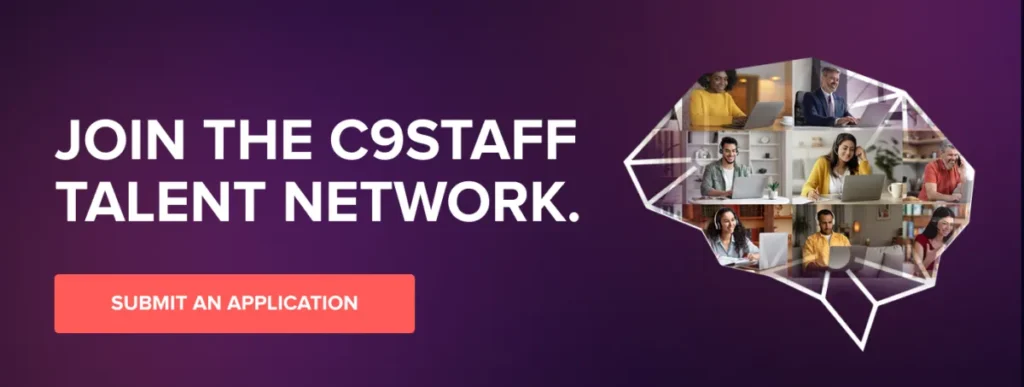Introduction

In the fast-paced world of tech startups, innovation isn’t just about having groundbreaking products; it’s also about ensuring that these innovations are accessible to users. Imagine being a project manager at one such startup, where the buzz and excitement of a newly launched product are overshadowed by a surge in customer support calls. Users find the product complex, the manuals perplexing, leaving them frustrated and dissatisfied.
Unlock the secret to crafting the perfect job description with our complimentary Technical Writer template. Designed for employers committed to excellence, this template is grounded in the fundamental principles and top practices of C9Staff’s proven hiring methodology. If your goal is to attract top-tier talent with precision and ease, look no further. Click the link below for immediate access to the best job description template on the market, and set the foundation for your hiring success.
TECHNICAL WRITer job description template

Enter a skilled technical writer. With a knack for clarity and precision, this new team member revamps your dense, jargon-laden documentation into crisp, easy-to-understand guides. It’s like watching a translator work magic, turning technical dialect into the everyday language. Within just a few months, a dramatic shift occurs: customer complaints plummet and user satisfaction scores soar. This scenario isn’t just a relief; it’s a revelation.
This story illustrates the often-underestimated power of technical writing. It’s not merely about creating documents; it’s about enhancing user experience, reducing errors, and democratizing technology. This is why the insights shared in this article, “Mastering the Art of Technical Writing: A Comprehensive Guide for Aspiring Writers and Employers,” are indispensable.
From the dual perspectives of job seekers and employers, this guide delves into the multifaceted role of technical writers. For those eager to enter this field, it offers a roadmap—from acquiring the necessary skills to landing your first job. For employers, it provides strategies to identify and hire writers who not only bring technical expertise but also add value to the user experience and product success.
Through comprehensive insights and actionable advice, this article aims to bridge the knowledge gaps and enhance readiness for the evolving demands of technical writing. Whether you are a novice looking to break into the field or a seasoned professional aiming to refine your craft, or even an employer on the hunt for top-notch writing talent, this guide is crafted for you. Let’s commence on this journey together, exploring how effective technical writing can transform complex information into clear, useful content that drives product success and user satisfaction.
Unveiling the Craft: The Essential Role of a Technical Writer
Understanding Technical Writing

Definition and Scope: Technical writing transforms complex information into clear, concise, and user-friendly documents. This field plays a vital role in helping users interact effectively with technology, understand intricate processes, and comply with stringent regulatory standards. Technical writers are essential across various domains, including software engineering, pharmaceuticals, finance, consumer electronics, and government documentation. Whether it’s drafting a user manual for a new smartphone or composing detailed regulatory submissions for a pharmaceutical company, technical writers make complex information accessible to all.
Importance in Industry: The value of technical writing extends far beyond simple documentation. Consider a software company that launches a cutting-edge application. Despite its innovative features, the product initially struggles in the market due to user confusion. By employing a team of skilled technical writers, the company revamps its user manuals and online help resources. These new, clearer guides enable customers to fully leverage the app’s capabilities, leading to increased customer satisfaction, reduced support calls, and a significant boost in sales.
Another example lies in the regulatory arena. A biotech firm facing an upcoming audit over its new drug submission benefits immensely from adept technical writers. By preparing precise, compliant, and comprehensible documentation, the writers help the firm navigate the audit smoothly, fostering trust and bolstering the company’s reputation within the industry.
Key Skills and Tools As a technical writer, several core skills and tools are crucial to your success:
Soft Skills: Exceptional communication skills are paramount. You must distill complex information into easily digestible content, requiring impeccable clarity and attention to detail. Time management and the ability to meet tight deadlines also play a critical role in this fast-paced environment.
Technical Skills: Proficiency in specialized documentation tools is necessary. Tools like MadCap Flare offer advanced features for creating professional and interactive documents, while Adobe FrameMaker is favored for its robust handling of large, complex documents. Additionally, familiarity with Microsoft Visio can aid in creating clear and informative diagrams.
If you’re looking to venture into technical writing, start by enhancing these skills. Engage in online courses focusing on technical communication, and get hands-on experience with these tools through trial versions or tutorials. By building both your soft and hard skills, you prepare yourself to meet the demands of a dynamic and rewarding career in technical writing.
By familiarizing yourself with the intricacies and tools of technical writing, you can start paving your way toward becoming a key player in transforming complex information into accessible knowledge, enhancing both user experience and corporate credibility.
Mastering the Art of Technical Writing: A Step-by-Step Guide to Excellence
For Aspiring Technical Writers

Visualize boarding on a career where your writing doesn’t just fill pages but empowers users to harness technology effectively and with ease. If this sounds like a journey you want to take, let’s explore the educational paths that can lead you there. Technical writing is a field where precision meets practicality, and getting the right education can set you apart. Consider pursuing a degree in Technical Communication, English, or Journalism, or enhance your skills with specialized certificates like those offered by the Society for Technical Communication (STC). Don’t overlook the plethora of online courses available on platforms like Coursera or LinkedIn Learning that are tailored specifically for budding technical writers like you.
Skill Development
As you refine your craft, understanding your audience is paramount. Each piece of documentation you create should be tailored for ease of use, with logical structuring and absolute clarity. To enhance your writing efficiency, immerse yourself in the tools of the trade. Familiarize yourself with content management systems and specialized software such as Adobe FrameMaker or MadCap Flare. Practice makes perfect, so take advantage of free trials and tutorials to build your proficiency. Remember, the more adept you become with these tools, the more valuable you are as a technical writer.
Building Your Portfolio
A compelling portfolio is your ticket to attracting potential employers. Start by compiling a variety of writing samples that showcase your ability to communicate complex information clearly across different formats and for different audiences. Include user manuals, how-to guides, FAQ sections, and even video tutorials you’ve scripted. For each sample, provide a brief description that outlines the purpose of the document, the audience it was intended for, and the tools you used to create it. This not only demonstrates your versatility but also your strategic thinking and problem-solving skills.
Finding Jobs
With your skills honed and your portfolio ready, it’s time to dive into the job market. Networking is key—connect with fellow technical writers online through forums and LinkedIn, and don’t shy away from attending industry conferences and seminars. These venues are goldmines for meeting potential employers and learning about new opportunities. Utilize job platforms that cater specifically to technical writing positions, such as WriteJobs or TechWhirl. Each application you send is a step towards your dream job, so tailor your resume and cover letter to highlight the skills and experiences most relevant to the positions you are applying for.
By embracing each of these steps, you’re not just preparing for a job in technical writing—you’re gearing up for a fulfilling career that evolves with technology and industry demands. Keep pushing forward, keep learning, and remember that every piece of writing you perfect is a step closer to your goal. Engage with this path actively, and watch as your efforts lead you to success in the realm of technical writing.
Elevate your career with C9Staff! If you’re ready to supercharge your professional journey and land your dream job, we invite you to submit your resume to our talent acquisition department. At C9Staff, we’re committed to connecting you with opportunities that match your skills and aspirations. If your qualifications align with our client requirements, our team will reach out to discuss potential opportunities that are tailored to your resume. Don’t miss out on this chance to advance your career—submit your resume today and discover where your talents can take you!

For Employers

Hiring the Right Talent
As an employer, the process of hiring the right technical writer should be approached with a strategy that balances technical skills with essential soft skills. Technical writers must not only be adept in using specific tools like MadCap Flare, Adobe FrameMaker, and Microsoft Visio but also excel in communication, organization, and problem-solving. During interviews, consider asking questions that delve into how candidates have handled past documentation challenges or how they approach complex projects under tight deadlines. For instance, you might ask, “Can you describe a time when you had to simplify complex information for a non-technical audience?” This question reveals the candidate’s ability to communicate effectively.
Writing Effective Job Descriptions
Crafting a job description that stands out is crucial in attracting the best technical writing talent. Your job postings should clearly outline the technical requirements of the role, but also emphasize the soft skills you value. Highlight your company culture and the unique benefits you offer. For example:
“Join our innovative team at [Company Name], where we value clear communication and a collaborative spirit. As a technical writer, you will translate complex product information into easy-to-understand content that enhances our customer experience. We support our employees with a robust benefits package, flexible work hours, and opportunities for professional growth.”
This kind of job description not only sets clear expectations but also markets your company as an attractive place to work.
Salary and Compensation Trends
Understanding the current compensation trends is vital to offering competitive packages that attract and retain top talent. Salaries for technical writers can vary significantly based on location, industry, and experience. For instance, technical writers in tech-centric cities like San Francisco or Seattle may command higher salaries due to the cost of living and competitive market. To remain competitive, consider offering a base salary that matches or exceeds the industry average in your region, supplemented with benefits such as health insurance, retirement plans, and performance bonuses. Flexible working conditions can also be a significant draw.
Enhancing Team Performance
Integrating technical writers into your teams effectively is key to maximizing productivity and fostering innovation. Promote an environment that values continuous learning and teamwork. Regular training sessions on the latest industry standards and documentation software can keep your writers at the cutting edge, while team-building activities can enhance collaboration. For example, periodic workshops focused on emerging technologies in your field can inspire your technical writers and encourage them to think creatively about how to improve your documentation.
Unlock the secret to crafting the perfect job description with our complimentary Technical Writer template. Designed for employers committed to excellence, this template is grounded in the fundamental principles and top practices of C9Staff’s proven hiring methodology. If your goal is to attract top-tier talent with precision and ease, look no further. Click the link below for immediate access to the best job description template on the market, and set the foundation for your hiring success.
TECHNICAL WRITer job description template

Advanced Techniques and Industry Trends

Latest Tools and Technologies
As you navigate the evolving landscape of technical writing, it’s crucial to stay abreast of the latest tools and technologies reshaping this field. Tools like MadCap Flare and Adobe RoboHelp have long been staples, enhancing document management and publishing capabilities. However, newer entrants like ClickHelp are pushing the boundaries even further. These platforms offer advanced features such as cloud-based access, which allows for seamless collaboration across global teams, and enhanced analytics to gauge user engagement and improve content effectiveness. Features like version control, easier localization, and integration with other software tools streamline the documentation process, making it easier to maintain consistency across extensive document suites.
Future of Technical Writing
The future of technical writing is being significantly shaped by artificial intelligence (AI) and machine learning. AI tools are now capable of automating routine tasks such as spell-checking and grammar, content tagging, and even some basic content generation, which can free up your time for more complex documentation needs. More sophisticated AI applications are enhancing content personalization, adapting information to fit the needs of different users automatically. For instance, AI can analyze user behavior and provide customized help based on previous interactions. As a technical writer, staying updated with these technologies and understanding how to leverage them in your work can set you apart from your peers and make you a more effective communicator.
Community and Continued Learning

Professional Associations and Groups
As a technical writer, becoming an active member of professional communities like the Society for Technical Communication (STC) or the Institute of Scientific and Technical Communicators (ISTC) is invaluable. These organizations offer not only networking opportunities but also a wealth of professional development resources that can propel your career forward. By participating in these groups, you gain access to industry insights, career advice, and exclusive training sessions—all of which enhance your professional capabilities. I encourage you to not only join these groups but also contribute to them. Share your experiences, volunteer for events, or write articles for their newsletters. Engaging with your community enriches your professional life and also contributes to the growth of the field itself.
Workshops and Conferences
Attending workshops and conferences like the STC Technical Communication Summit or Write the Docs is more than just an educational commitment—it’s a career investment. These events are crucial for keeping up with the latest industry trends, learning new skills, and networking with peers. Beyond just attending, consider presenting your work or leading a workshop. Sharing your knowledge not only positions you as an expert but also deepens your understanding of your own work through discussions and feedback. This active participation can open doors to new opportunities and collaborations.
Ongoing Education
In the fast-evolving field of technical writing, continuous education is key to staying relevant and competitive. Platforms like LinkedIn Learning and Coursera offer courses that can help you keep up with the latest tools, technologies, and methodologies. Commit to setting personal development goals each year and develop a plan to achieve them. Whether it’s obtaining a new certification, mastering a new writing tool, or keeping up with industry best practices, ongoing education ensures you remain at the forefront of your profession.
Discover how C9Staff can transform your hiring process. If you’re looking to source, recruit, hire, train, manage, and deploy the ideal technical writer for your organization, we invite you to schedule a free exploratory call with one of our expert account managers. During this call, we’ll attentively listen to your specific needs and provide endorsements for potential candidates at no cost, helping you evaluate the best talent available at competitive prices. Take the first step towards optimizing your team with top-tier talent by scheduling your free call today.

Conclusion

As we conclude this comprehensive guide on mastering the art of technical writing, it’s essential for you, whether you are an aspiring writer or an employer, to reflect on the key insights we’ve explored together. We began by understanding the vast scope of technical writing, recognizing its pivotal role across various industries—from technology to healthcare. We delved into the essential skills and tools that form the foundation of effective technical writing, emphasizing not only the technical prowess required but also the critical soft skills like communication and problem-solving.
We also discussed the undeniable benefits of continuous learning and professional development, highlighting how staying current with industry trends through workshops, courses, and certifications is crucial for career growth and adaptation. For employers, we outlined strategies for attracting, hiring, and integrating technical writers into teams, ensuring that their skills are leveraged to enhance business processes and customer engagement.
Now, I urge you to not just pursue excellence in your technical writing endeavors but to also embrace the continuous journey of learning and improvement. The field of technical writing is ever-evolving, and staying ahead requires a proactive approach to challenges and a commitment to innovate continually. Whether you are drafting a user manual or preparing a white paper, remember that your work has the power to transform user experiences and influence the success of products and services.




